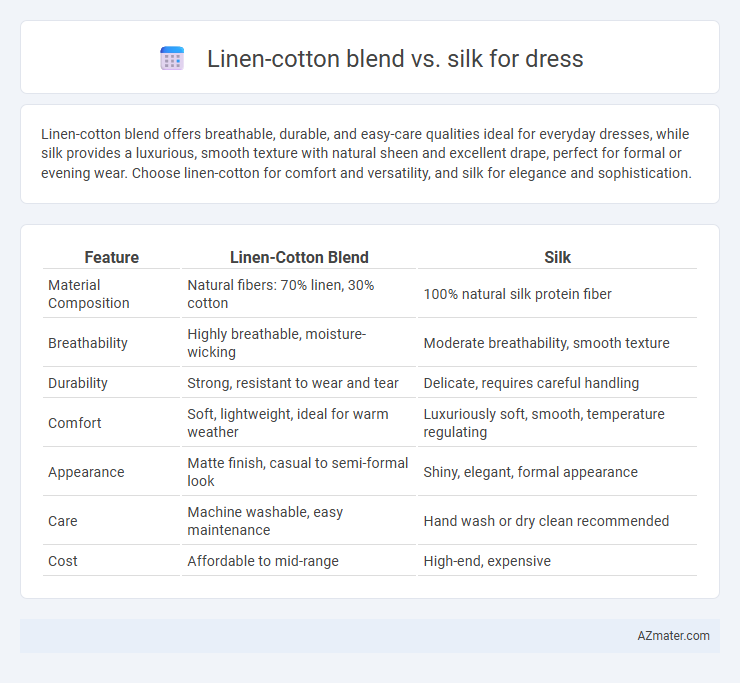Linen-cotton blend offers breathable, durable, and easy-care qualities ideal for everyday dresses, while silk provides a luxurious, smooth texture with natural sheen and excellent drape, perfect for formal or evening wear. Choose linen-cotton for comfort and versatility, and silk for elegance and sophistication.
Table of Comparison
| Feature | Linen-Cotton Blend | Silk |
|---|---|---|
| Material Composition | Natural fibers: 70% linen, 30% cotton | 100% natural silk protein fiber |
| Breathability | Highly breathable, moisture-wicking | Moderate breathability, smooth texture |
| Durability | Strong, resistant to wear and tear | Delicate, requires careful handling |
| Comfort | Soft, lightweight, ideal for warm weather | Luxuriously soft, smooth, temperature regulating |
| Appearance | Matte finish, casual to semi-formal look | Shiny, elegant, formal appearance |
| Care | Machine washable, easy maintenance | Hand wash or dry clean recommended |
| Cost | Affordable to mid-range | High-end, expensive |
Introduction to Linen-Cotton Blend and Silk for Dresses
Linen-cotton blends combine the breathability and durability of linen with the softness and easy care of cotton, making them ideal for comfortable, everyday dresses that suit warm weather. Silk offers a luxurious sheen and smooth texture, providing elegance and a lightweight feel perfect for formal or special occasion dresses. Both fabrics bring unique qualities to dressmaking, with linen-cotton blends excelling in casual wear and silk delivering sophistication and drape.
Fabric Composition and Characteristics
Linen-cotton blends combine the durability and breathability of linen with the softness and flexibility of cotton, creating a lightweight fabric ideal for warm weather dresses. The natural fibers in this blend allow excellent moisture absorption and quick drying, offering comfort and ease of care, while maintaining a slightly textured appearance. Silk, composed mainly of protein fibers, delivers a smooth, lustrous finish with superior drape and natural elasticity, making it a luxurious option that excels in elegance and temperature regulation.
Comfort and Breathability Comparison
Linen-cotton blends offer superior breathability and moisture-wicking properties, making them highly comfortable for warm-weather dresses due to the natural fibers' ability to regulate temperature effectively. Silk, while smooth and luxurious, tends to retain heat and can trap moisture, often resulting in less breathability compared to linen-cotton fabrics. For comfort in hot climates, linen-cotton blends are generally preferred over silk, as they provide better airflow and keep the skin dry.
Durability and Longevity
Linen-cotton blend fabrics exhibit high durability and longevity due to the strength of flax fibers combined with the softness of cotton, making them resistant to frequent washing and everyday wear. Silk, while luxurious and smooth, tends to have a delicate fiber structure that can weaken over time with exposure to sunlight, moisture, and friction, requiring careful maintenance for long-lasting use. Choosing linen-cotton blends often results in more resilient dresses suitable for regular use, whereas silk dresses are better maintained for occasional wear to preserve their texture and sheen.
Seasonal Suitability: Warm vs. Cool Weather
Linen-cotton blends offer excellent breathability and moisture-wicking properties, making them ideal for warm weather due to their lightweight and airy texture. Silk, with its natural temperature-regulating qualities, adapts comfortably to both cool and warm climates but tends to feel cooler in hot conditions and warmer in mild cold. Choosing between linen-cotton blend and silk depends on the specific seasonal needs, where linen-cotton suits hot, humid environments and silk provides versatile comfort across transitional seasons.
Appearance and Texture Differences
Linen-cotton blend dresses exhibit a matte, slightly textured appearance with a natural, breathable feel that offers a casual yet refined look. Silk dresses showcase a smooth, lustrous surface with a soft, fluid texture that drapes elegantly, creating a luxurious and polished appearance. The linen-cotton blend provides subtle texture and structure, while silk delivers a glossy sheen and a lightweight, silky touch.
Maintenance and Care Requirements
Linen-cotton blends require regular ironing due to their tendency to wrinkle, but are generally machine washable and durable, making maintenance straightforward. Silk dresses demand delicate care, such as hand washing or dry cleaning, to preserve their smooth texture and natural sheen, and are prone to water spots and damage from harsh detergents. Proper storage in a cool, dry place away from direct sunlight is crucial for both fabrics to prevent discoloration and fiber degradation.
Cost and Affordability Factors
Linen-cotton blends offer a more affordable option for dresses, typically costing 30-50% less than silk, making them accessible for budget-conscious shoppers. The durability and easy care of linen-cotton blends reduce long-term expenses compared to the delicate maintenance required by silk, which often demands professional cleaning. For cost efficiency and everyday wear, linen-cotton blends provide significant savings without compromising comfort.
Eco-Friendliness and Sustainability
Linen-cotton blend fabrics offer superior eco-friendliness due to their natural fibers, biodegradability, and lower water and pesticide usage compared to conventional cotton and silk production. Silk, while luxurious, involves energy-intensive sericulture and may raise ethical concerns regarding silkworm cultivation, impacting its sustainability profile. Choosing linen-cotton blends supports sustainable fashion by reducing environmental impact and promoting renewable, biodegradable textile options.
Which Fabric is Best for Different Dress Styles?
Linen-cotton blend is ideal for casual and summer dresses due to its breathability, durability, and lightweight texture, making it perfect for relaxed styles like sundresses and shirt dresses. Silk is preferred for formal and evening dresses because of its luxurious sheen, smoothness, and elegant drape, enhancing styles such as gowns and cocktail dresses. Choosing between the two depends on the dress style's need for comfort and airflow versus sophistication and fluidity.

Infographic: Linen-cotton blend vs Silk for Dress
 azmater.com
azmater.com